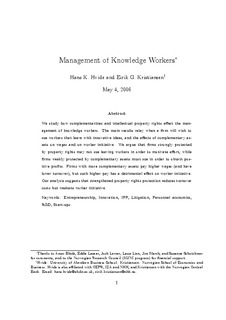| dc.contributor.author | Hvide, Hans K. | |
| dc.contributor.author | Kristiansen, Eirik Gaard | |
| dc.date.accessioned | 2006-07-11T09:00:03Z | |
| dc.date.available | 2006-07-11T09:00:03Z | |
| dc.date.issued | 2006-05 | |
| dc.identifier.issn | 0804-6824 | |
| dc.identifier.uri | http://hdl.handle.net/11250/162710 | |
| dc.description.abstract | We study how complementarities and intellectual property rights affect the management
of knowledge workers. The main results relay when a firm will wish to
sue workers that leave with innovative ideas, and the effects of complementary assets
on wages and on worker initiative. We argue that firms strongly protected
by property rights may not sue leaving workers in order to motivate effort, while
firms weakly protected by complementary assets must sue in order to obtain positive
profits. Firms with more complementary assets pay higher wages (and have
lower turnover), but such higher pay has a detrimental effect on worker initiative.
Our analysis suggests that strengthened property rights protection reduces turnover costs but weakens worker initiative. | en |
| dc.format.extent | 295518 bytes | |
| dc.format.mimetype | application/pdf | |
| dc.language.iso | eng | en |
| dc.publisher | Norwegian School of Economics and Business Administration. Department of Economics | en |
| dc.relation.ispartofseries | Discussion paper | en |
| dc.relation.ispartofseries | 2006:20 | en |
| dc.subject | entrepreneurship | en |
| dc.subject | innovation | en |
| dc.subject | IPP | en |
| dc.subject | litigation | en |
| dc.subject | personnel economics | en |
| dc.subject | R & D | en |
| dc.subject | start-ups | en |
| dc.title | Management of knowledge workers | en |
| dc.type | Working paper | en |
